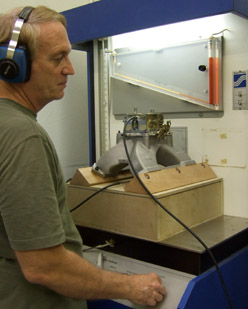|
About Us
|
 |
 |
 |
 |
 |
Airflow Testing of Carburetors

Measuring the airflow is the easy part. Measuring the delta P accurately is more challenging. The vacuum probe in the flowbench that measures the delta P is supposed to measure just the vacuum. A poor choice of the type of probe used, and/or the poor placement of the probe in the flowbench, can allow the probe to be affected by air velocity and air turbulence, making the delta P reading from the probe inaccurate and unstable. This inaccurate delta P reading, in turn, makes the airflow reading inaccurate, and depending on the direction of air velocity and turbulence around the probe, the airflow reading can be dramatically higher or lower than the real airflow. The stock delta P probe in my Superflow 300 bench was seriously affected by air velocity and turbulence around the probe. So I replaced it with a different type of probe in a different location, and now the delta P reading is much less affected by air velocity and turbulence.

To answer this question, I built a carburetor flow fixture that incorporates a single plane small block Chevrolet intake commonly used on 700 HP oval track engines. A new style delta P probe is used to measure plenum vacuum, and another is used to measure the vacuum drawing air through the ports of the manifold. As I had suspected, the pressure recovery of the manifold is better than some of the adapters I used before, and worse than others. My standard test for total carb airflow now consists of measuring airflow on an adapter that has really good pressure recovery... pressure recovery that you would see with a really good, professionally ported, single plane intake. That way, carb and carb spacer airflow development will show improvements,positive OR negative, and not be masked by the ability of the flow bench adapter to flow and allow good pressure recovery. © Norm Schenck/CFS